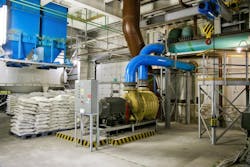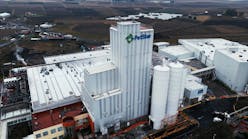From lab to industry: Cutting-edge filtration technologies and their applications in water treatment
Water filtration technologies have come a long way since they were first invented in the early 1800s. Rather than using wool and other household items, modern filtration technology relies on reverse osmosis membranes, organic compounds and other new technologies to filter water. And it is continuing to advance.
If you are curious and want to know more about how water treatment technologies are progressing, you have come to the right place. This article will lay out how water filtration started, how it has progressed through the years and where it is at today.
What is water filtration and treatment?
Before we get too carried away with where water filtration is at today, let's briefly examine what exactly industrial water filtration is.
Industrial water treatment
Industrial water filtration refers to the processes used to treat water before it enters the water supply. During this process, a series of filters and chemical additives are used to remove contaminants, pollutants, bacteria, debris and other nasty things you do not want in your water.
Wastewater treatment is important because, without it, we would not have any potable water. You see, the water that enters your home comes from a wide range of sources, such as rivers, lakes, reservoirs and more. Therefore, it is full of contagions that could be harmful if they are not removed using the following methods.
- Wastewater starts by going through filters that remove large debris and residue.
- The water then passes through a second filter that removes smaller particles and debris.
- With the larger chunks removed, the water goes through a special filter to remove organic compounds. While some plants use a trickling filter, most use activated sludge.
- Chlorine then gets added to the water to kill any bacteria that may be present.
- In some cases, the water is also run through a UV filter that removes any bacteria and contaminants left over.
Water treatment technology: then and now
As we said before, water treatment systems have come a long way. The very first water treatment system was invented in Scotland in 1804 by Robert Thom. It consisted of charcoal, wool and sponge, which is not much better than the first wastewater treatment system, which relied on slow sand filtration.
Luckily, those days are long gone, and water treatment technologies have never been more advanced.
Strainers
Strainers are the first entities used in water treatment processes. They have the job of filtering out large debris and sediment in the earliest stages of the treatment process. Due to advancements, strainers are now able to remove more waste and contaminants than ever before.
The most recent advancement with strainers is that they use membrane filtration. Several forms of technology include Electrodialysis Metathesis, which uses desalination applications, and semi-permeable membranes. Both of these methods result in more efficiency and fresher drinking water.
Bag filtration
Many industrial water treatment systems have also started to include bag filtration. Industrial bag filtration is a highly effective way of filtering both liquid and solid waste out of water. The bag sits inside the filter housing, removing contaminants as they pass through.
Cartridge filtration
Another major advancement is in the invention and improvement of cartridge filtration. Cartridge filters, such as those used in industrial water supplies, are some of the longest-lasting water treatment solutions on the market. Cartridge filters sit in whatever water you are treating in a way so that the water has to flow through the filter in order to reach its destination.
Oxidizing agents
If you don't like to use chlorine and other potentially harmful chemicals to purify water, there have also been advancements with oxidizing agents. Oxidizing agents are the purification solutions used to remove bacteria, viruses and other harmful particles from water. While chlorine used to be the only way to do this, here are a few modern alternatives:
- Ozonation — this is a mixture of oxygen and gas atoms that get passed through an electric field.
- Hydrogen peroxide — this household cleaning remedy can remove contaminants and discoloration from water.
- Photocatalysis — this process uses light energy to clean and purify water.
- Fenton's reagent — this uses a combination of hydrogen peroxide and iron to clean water.
- Nanotechnology — this process uses carbon nanotubes to clean and purify water.
Industries that rely on water treatment systems
There are a number of industries that rely on water treatment systems.
- Oil and gas — These industries use water to purify and refine their products.
- Food and beverage — Nearly everything in the food and beverage industries relies on water treatment solutions to purify and produce their products.
- Power — Water is a renewable resource that often gets used in the creation of electricity.
- Process manufacturing — As with the beverage and food industries, nearly all process manufacturing facilities rely on clean water to produce their products.
- Pharmaceutical — The only way to produce medications and drugs for treatment is to have clean water.
As you can see, many industries rely on water purification services to function. Because of how dependent these industries are on water, they need purification and treatment systems to continue to advance. In addition to making water cleaner and safer, advancements in water treatment will also make the process more efficient, which is important for cost savings.
Mark Ligon is the marketing manager at Commercial Filtration Supply. He oversees the development of business strategies and marketing of filtration products, including bag filters, cartridge filters, and strainers. Ligon writes about various liquid filtration applications to educate process and facility managers on best practices, ensuring they properly understand and care for their filter systems.



